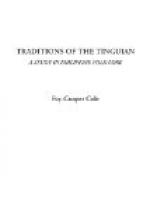[47] See Cole and Laufer, Chinese Pottery in the Philippines (Pub. Field Museum of Natural History, Vol. XII, No. 1).
[48] This is entirely in agreement with Chinese records. The Islands always appeared to the Chinese as an Eldorado desirable for its gold and pearls.
[49] See p. 21, note 1.
[50] See p. 10, note 1.
[51] A bamboo pole, about ten feet long, one end of which is slit into several strips; these are forced apart and are interwoven with other strips, thus forming a sort of basket.
[52] See Cole, Distribution of the Non-Christian Tribes of Northwestern Luzon (American Anthropologist, Vol. II, No. 3, 1909, pp. 340, 341).
[53] See p. 12.
[54] See p. 13, note 5.
[55] Among the Ifugao, the lowest of the four layers or strata which overhang the earth is known as Kabuniyan. See Beyer, Philippine Journal of Science, Vol. VIII, 1913, No. 2, p. 98.
[56] See p. 11.
[57] An Ifugao myth gives sanction to the marriage of brother and sister under certain circumstances, although it is prohibited in every day life. Beyer, Philippine Journal of Science, Vol. VIII, 1913, No. 2, pp. 100 ff.
[58] As opposed to the spirit mate of Aponitolau.
[59] According to Ling Roth, the Malanaus of Borneo bury small boats near the graves of the deceased, for the use of the departed spirits. It was formerly the custom to put jars, weapons, clothes, food, and in some cases a female slave aboard a raft, and send it out to sea on the ebb tide “in order that the deceased might meet with these necessaries in his upward flight.” Natives of Sarawak and British North Borneo, Vol. I, p. 145, (London, 1896). For notes on the funeral boat of the Kayan, see Hose and McDougall, Pagan Tribes of Borneo, Vol. II, p. 35.—Among the Kulaman of southern Mindanao an important man is sometimes placed in a coffin resembling a small boat, which is then fastened on high poles near to the beach. Cole, Wild Tribes of Davao District, Mindanao (Pub. Field Museum of Natural History, Vol. XII, No. 2, 1913).—The supreme being, Lumawig, of the Bontoc Igorot is said to have placed his living wife and children in a log coffin; at one end he tied a dog, at the other a cock, and set them adrift on the river. See Jenks, The Bontoc Igorot, p. 203, (Manila, 1905); Seidenadel, The Language of the Bontoc Igorot, p. 502 ff., (Chicago, 1909).
[60] For similar omens observed by the Ifugao of Northern Luzon, see Beyer, Origin Myths of the Mountain peoples of the Philippines (Philippine Journal of Science, Vol. VIII, 1913, No. 2, p. 103).
[61] Page 6, note 3.
[62] See tale 22.
[63] For a discussion of this class of myths, see Waterman, Jour. Am. Folklore, Vol. XXVII, 1914, p. 13 ff.; Lowie, ibid., Vol. XXI, p. 101 ff., 1908; P.W. Schmidt, Grundlinien einer Vergleichung der Religionen und Mythologien der austronesischen Voelker, (Wien, 1910).




